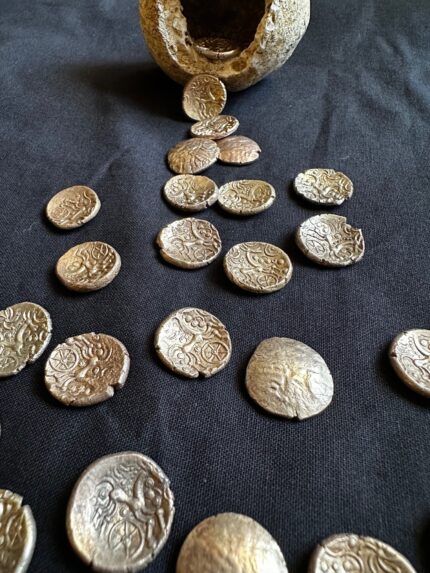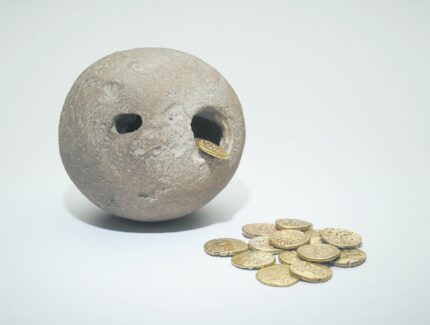 The British Museum has released the latest annual report of the Portable Antiquities Scheme (PAS) which marks that 2022 had the highest number of Treasure cases (1,378) ever reported in a single year. The report highlights some of the most stand-out Treasure finds in 2022, including an intriguing Iron Age hoard of gold coins found inside a hollow flint globule.
The British Museum has released the latest annual report of the Portable Antiquities Scheme (PAS) which marks that 2022 had the highest number of Treasure cases (1,378) ever reported in a single year. The report highlights some of the most stand-out Treasure finds in 2022, including an intriguing Iron Age hoard of gold coins found inside a hollow flint globule.
The hoard was discovered on New Year’s Day 2023 in East Garston, West Berkshire. It consists of 26 Iron Age gold staters found inside a naturally-occurring hollow flint ball. The staters are of the “Savernake Wreaths” type, produced in East Wiltshire in the late Iron Age (50-20 B.C.). They feature a stylized design of crossed wreaths on one side and a horse at gallop facing right with a spiral above it and a wheel below.
Hollow nodules of flint are commonly found in the upper strata of the Chalk, a limestone geological layer in southern and eastern England formed between 90 million and 66 million years ago. Before it hardened, the Chalk was mud on the sea floor. Dissolved silica filled gaps in the compacting mud, forming nodules sometimes around sea creatures like urchins and cockles that left hollows inside the nodules once they decayed.
 This is not the first coin hoard found in a flint nodule. Iron Age coins cached inside nodules have been found in Kent, Oxfordshire and Wiltshire. Using hollow flint balls as containers for gold coins appears to have been an established practice in Iron Age England. The nodules often have natural holes and openings making them handy piggy banks even unmodified. Sometimes a hole would be enlarged to fit the coins more easily. The East Garston flint nodule had no natural hole; a piece deliberately broken to create the opening.
This is not the first coin hoard found in a flint nodule. Iron Age coins cached inside nodules have been found in Kent, Oxfordshire and Wiltshire. Using hollow flint balls as containers for gold coins appears to have been an established practice in Iron Age England. The nodules often have natural holes and openings making them handy piggy banks even unmodified. Sometimes a hole would be enlarged to fit the coins more easily. The East Garston flint nodule had no natural hole; a piece deliberately broken to create the opening.
The staters and flint ball were declared Treasure, as all coins hoards have been since the Treasure Act was passed in 1996. Under the terms of that legislation, the definition of Treasure in the UK has been two or more prehistoric objects made of metal, any metallic object composed of at least 10% silver or gold by weight that is at least 300 years old and coins in hoard 300 years or older. Once an object is determined by a coroner’s court to be Treasure, it becomes property of the crown and is offered to a local museum for the amount of its assessed value. The money is then split between the finder and landowner.
This definition has allowed exceptionally unique and important archaeological artifacts like the Ryedale Hoard, the Crosby Garret helmet, the Roman licking dog and the Allectus aureus to fall through the cracks. Despite being undisputed and irreplaceable archaeological treasures, they were not Treasure according to the short-sighted legal definition and were therefore returned to the finders who then sold them to the highest bidder.
In 2019, the UK’s Department for Digital, Culture, Media and Sport announced a plan to revise the Treasure Act to plug the loophole. The updated language would define Treasure as any object that is at least partially metal, at least 200 years old and is deemed to provide “exceptional insight” into British or regional history because of its rarity, location or connection to a historical personage or event. After five long years, the revision is finally about to take effect. The new criteria will apply to all objects found after July 30th, 2023.